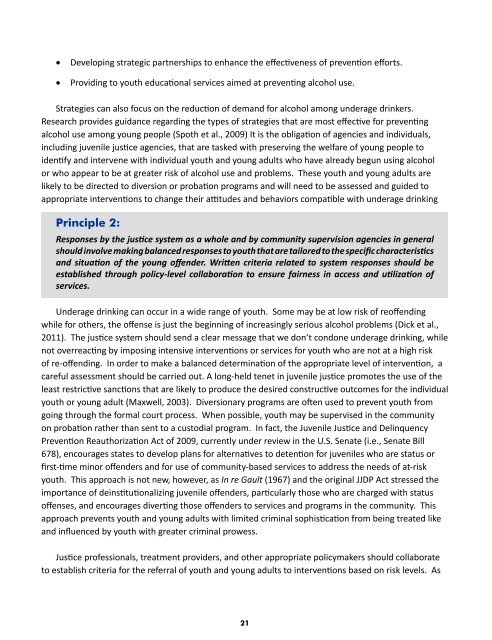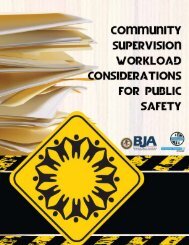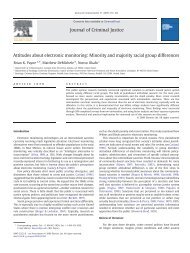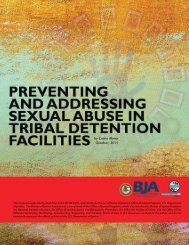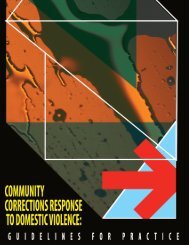Intervention Principles and Practice Guidelines for - Underage ...
Intervention Principles and Practice Guidelines for - Underage ...
Intervention Principles and Practice Guidelines for - Underage ...
You also want an ePaper? Increase the reach of your titles
YUMPU automatically turns print PDFs into web optimized ePapers that Google loves.
• Developing strategic partnerships to enhance the effectiveness of prevention ef<strong>for</strong>ts.<br />
• Providing to youth educational services aimed at preventing alcohol use.<br />
Strategies can also focus on the reduction of dem<strong>and</strong> <strong>for</strong> alcohol among underage drinkers.<br />
Research provides guidance regarding the types of strategies that are most effective <strong>for</strong> preventing<br />
alcohol use among young people (Spoth et al., 2009) It is the obligation of agencies <strong>and</strong> individuals,<br />
including juvenile justice agencies, that are tasked with preserving the welfare of young people to<br />
identify <strong>and</strong> intervene with individual youth <strong>and</strong> young adults who have already begun using alcohol<br />
or who appear to be at greater risk of alcohol use <strong>and</strong> problems. These youth <strong>and</strong> young adults are<br />
likely to be directed to diversion or probation programs <strong>and</strong> will need to be assessed <strong>and</strong> guided to<br />
appropriate interventions to change their attitudes <strong>and</strong> behaviors compatible with underage drinking<br />
Principle 2:<br />
Responses by the justice system as a whole <strong>and</strong> by community supervision agencies in general<br />
should involve making balanced responses to youth that are tailored to the specific characteristics<br />
<strong>and</strong> situation of the young offender. Written criteria related to system responses should be<br />
established through policy-level collaboration to ensure fairness in access <strong>and</strong> utilization of<br />
services.<br />
<strong>Underage</strong> drinking can occur in a wide range of youth. Some may be at low risk of reoffending<br />
while <strong>for</strong> others, the offense is just the beginning of increasingly serious alcohol problems (Dick et al.,<br />
2011). The justice system should send a clear message that we don’t condone underage drinking, while<br />
not overreacting by imposing intensive interventions or services <strong>for</strong> youth who are not at a high risk<br />
of re-offending. In order to make a balanced determination of the appropriate level of intervention, a<br />
careful assessment should be carried out. A long-held tenet in juvenile justice promotes the use of the<br />
least restrictive sanctions that are likely to produce the desired constructive outcomes <strong>for</strong> the individual<br />
youth or young adult (Maxwell, 2003). Diversionary programs are often used to prevent youth from<br />
going through the <strong>for</strong>mal court process. When possible, youth may be supervised in the community<br />
on probation rather than sent to a custodial program. In fact, the Juvenile Justice <strong>and</strong> Delinquency<br />
Prevention Reauthorization Act of 2009, currently under review in the U.S. Senate (i.e., Senate Bill<br />
678), encourages states to develop plans <strong>for</strong> alternatives to detention <strong>for</strong> juveniles who are status or<br />
first-time minor offenders <strong>and</strong> <strong>for</strong> use of community-based services to address the needs of at-risk<br />
youth. This approach is not new, however, as In re Gault (1967) <strong>and</strong> the original JJDP Act stressed the<br />
importance of deinstitutionalizing juvenile offenders, particularly those who are charged with status<br />
offenses, <strong>and</strong> encourages diverting those offenders to services <strong>and</strong> programs in the community. This<br />
approach prevents youth <strong>and</strong> young adults with limited criminal sophistication from being treated like<br />
<strong>and</strong> influenced by youth with greater criminal prowess.<br />
Justice professionals, treatment providers, <strong>and</strong> other appropriate policymakers should collaborate<br />
to establish criteria <strong>for</strong> the referral of youth <strong>and</strong> young adults to interventions based on risk levels. As<br />
21


